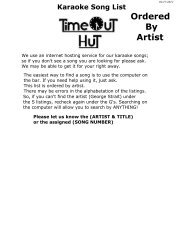+Mike Caro - Caros Book Of Poker Tells.pdf - Time Out Hut
+Mike Caro - Caros Book Of Poker Tells.pdf - Time Out Hut
+Mike Caro - Caros Book Of Poker Tells.pdf - Time Out Hut
You also want an ePaper? Increase the reach of your titles
YUMPU automatically turns print PDFs into web optimized ePapers that Google loves.
XI. Protecting a Hand<br />
Most players unconsciously guard good cards more carefully than bad cards. While this is more<br />
common among weak players, the trait is found at all levels of play and in all forms of poker.<br />
Even the rarely played five card stud provides instances of this tell, because players with good<br />
hands tend to show more concern when you reach toward their hole card. <strong>Of</strong> course, you must<br />
not actually touch or even physically approach the opponent's hole card — that's poor poker<br />
etiquette. But you can make an ambiguous gesture that your opponent might misinterpret as an<br />
invasion of his space. In response, an opponent holding a strong hand will usually jerk<br />
unconsciously and assume a more rigid position. He may even fend you off with a stiff arm used<br />
as a barrier. Players with weak hands are more lax. They wouldn't care if you reached all the<br />
way over and exposed the hole card. Then they could argue that they were entitled to a portion<br />
of the pot.<br />
This kind of protective reaction applies to all varieties of poker. However, you don't need to<br />
make threatening gestures toward an opponent's cards to utilize this tell. Most opponents will<br />
give you clues without any provocation, and this is especially easy to understand if we focus on<br />
draw poker.<br />
TELL #22<br />
TITLE: I better not let these get away.<br />
CATEGORY: Protecting a Hand.<br />
DESCRIPTION: Most draw players look at their cards in a more clandestine manner than<br />
what's shown in Photo 43. In small-limit home games and in public casinos where flexible<br />
plastic cards are used, the method pictured is sometimes observed. In any case, what's important<br />
is whether the player protects his cards after he sees them. Two aces and a king on the first three<br />
cards is a nice catch, so in Photo 44, the player pushes them securely into his left hand. In Photo<br />
45, the final two cards are viewed: ace and king. That gives this player aces-full. Photo 46<br />
shows him squeezing this treasure very tightly between his fingers.<br />
MOTIVATION: Most people guard important belongings.<br />
RELIABILITY:<br />
• Weak players = 90%<br />
• Average players = 80%<br />
• Strong players = 70%<br />
VALUE PER HOUR:<br />
• $1 limit = $1.10<br />
• $10 limit = $4.40<br />
• $100 limit = $16.00<br />
DISCUSSION: Be cautious in using this tell, because some players guard all hands. A few will<br />
even use a carefully guarded hand as a ploy to make you think that their weak hand is awesome.<br />
That's rare, though, because most players realize that the manner in which a hand is guarded is<br />
not something most opponents observe. Knowing this, a player who's weak will not generally go<br />
to the trouble of guarding his hand for deception. For that reason, protecting a hand is a topic<br />
that fits neatly into this chapter.<br />
The governing truth is that closely protected hands are usually strong. Sometimes, you can even<br />
draw a correlation between the amount of protection and the exact strength of the hand. In this<br />
photo sequence, the player picks up a full house and makes certain it is secure. There's one other<br />
62



